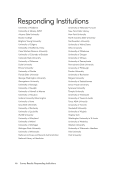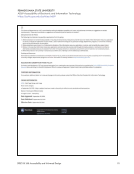37 SPEC Kit 358: Accessibility and Universal Design The Libraries will be moving to a more regular check once we have access to SiteImprove. For now, we check as new content is added. The library does check to see if vendors are self-reporting compliance with web accessibility laws. The library website, and library-generated media are centrally controlled. This means that the content is vetted for accessibility before it can be posted. Multimedia content in our catalogue and e-reserve is made accessible upon request. While we provide document accessibility training to library staff, we don’t enforce document accessibility regulations on the content they produce. The university has a site license with SiteImprove, as website review service that includes accessibility reviews as part of its routine procedures. In general, any other materials produced or acquired by the library that may involve accessibility features does not get tested beyond the initial purchase or creation. There is no centralized group to verifies that these resources are being checked on a regular basis. This is really reviewed more on an as-needed basis rather than on a fixed annual schedule. This question is difficult to answer as we generally test all new web content/development, multimedia, etc. at the time of creation, or consider during purchase in the case of film, etc. We also periodically review websites and pages as we discover issues. In terms of regular review of existing content, there is generally no known regular check. This is undergoing change. We are putting in workflows to check new content before publishing and spot checking updated content on a frequent quarterly basis. We are about to embark on a website refresh, and our historical website is harder to evaluate. We have plans to employ a tool that will verify accessibility daily. We assume vendors are checking their own products for compliance. We have a plan to focus more on making our website accessible and compliant with standards set by the university. We look for accessibility when we acquire resources and we caption our videos, but we don’t go back and test them. 25. Some institutions integrate accessibility procedures into their collection development policies and procedures. Has your institution integrated accessibility into your collection development policy or procedures? N=64 Yes 21 33% No 43 67% Please comment on reasons for this approach. N=31 Answered Yes N=17 Because we have an inclusive/universal design approach to services and because acquiring accessible materials is more sustainable than remediation. For large database purchases only For new products, we investigate accessibility and for videos we attempt to ensure that captions exist. Have begun via availability of BTAA standardized accessibility language in e-resource licenses. Institutional initiative for diversity & inclusion to help pressure change. Also purchase e-books on request as a fast means to accommodate patrons.




























































































































































